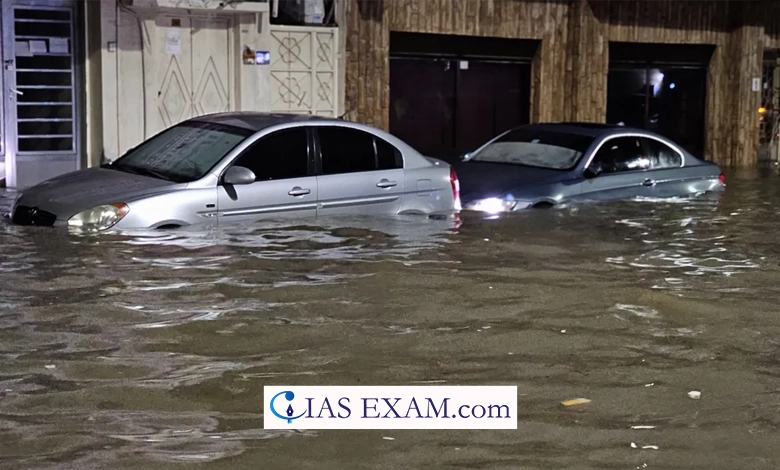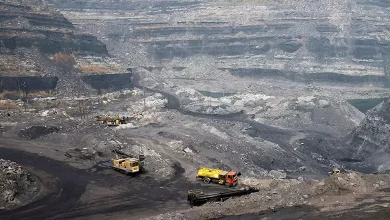
Context
According to the researchers, the Deadly storms that submerged Dubai and caused fatalities in Oman were likely made worse by climate change.
Key Highlights
- Fatalities in Oman were in all likelihood made worse by climate change.
- Over a duration of less than 24 hours, the United Arab Emirates experienced its heaviest rainfall since statistics started 75 years in the past.
- Dubai — a glitzy wasteland city accustomed to months with no precipitation at all — experienced the equivalent of more than a year and a half’s worth of rain in that time.
- Also, the Arabian Peninsula, on which the UAE and Oman take a seat, once in a while reviews extreme bouts of rain in April and May from what’s called mesoscale convective structures — numerous thunderstorms that together act as a single weather system.
Reasons for the Extreme Rainfall
- Global Warming: A crew of 21 scientists and researchers, underneath the World Weather Attribution initiative, observed that climate change was causing severe rainfall occasions in the nations — which usually fall at some point of El Niño years — between 10 and 40% more than they would have been without global warming.
- The ecosystem in a 1.2-degree warmer global climate can maintain 8.4% more moisture, that’s making excessive rain occasions more intense.
- El Nino: The rainfall befell after months of hotter-than-common sea surface temperatures partly caused by El Niño – which is whilst heat waters rise to the surface of elements of the Pacific Ocean.
- The higher ocean temperatures brought greater moisture to the atmosphere, making heavy rainfall much more likely.
- Infrastructure and Soil of the Region: Cities constructed without good enough hurricane control blended with very dry soils within the location that struggle to absorb extra water also made the effect worse.
- The UAE and Oman floods have shown that even dry areas may be strongly laid low with precipitation activities, a threat that is increasing with increasing global warming because of fossil fuel burning.
What are Floods?
-
- Floods are the maximum frequent kind of herbal catastrophe and occur whilst an overflow of water submerges land that is usually dry.
- Types of Floods
-
- Flash floods are because of rapid and excessive rainfall that raises water heights fast, and rivers, streams, channels or roads can be overtaken.
- River floods are induced when consistent rain or snow melt forces a river to exceed ability.
- Coastal floods are caused by storm surges associated with tropical cyclones and tsunamis.
- Urban flooding occurs due to land development. Permeable soil layers are being replaced via impermeable paved surfaces, through which water can’t infiltrate.
Causes of Floods
- Natural Causes:
-
- Prolonged rainfall: When rain falls for a prolonged period of time, the soil can emerge as saturated. When water is not able to infiltrate into the saturated soil, it is forceed to waft over the soil, hence increasing surface runoff.
- Intense/Heavy rainfall: When rain falls closely; the raindrops hit the ground with a pressure. This can cause the rain drops to dance off the soil in place of infiltrating into the soil.
- The water from the rain is then compelled to go with the flow over the floor as a substitute, as a consequence increasing the floor runoff.
- Relief refers to the difference in top between the top point and the bottom point on land.
- When rain falls, the floor runoff can move in no time from mountainous or hilly areas to low lying areas making those low mendacity regions greater prone to flooding.
- Urban flooding
- Deforestation: The lack of flowers encourages water to drift over the surface rather than infiltrate into the soil for that reason growing floor runoff.
- Poor land use practices: Slash and burn agriculture, over-cultivation and overgrazing in the end cause the soil to become infertile and unable to preserve forest increase.
- Consequently, the dearth of green cover encourages water to flow over the surface in preference to infiltrate into the soil as a result of growing surface runoff.
- Urbanization results in the substitute of permeable soil with that of an impervious layer of pitch and concrete, through which water cannot infiltrate.
- Improper waste disposal: Oftentimes, garbage that isn’t always well disposed enters into drainage systems and clogs drains.
- Collapsed Dams: If the dams begin to fall apart, they’ll discharge more water downstream, resulting in flooding.
- Climate change: Uncontrolled human sports can make contributions to climatic adjustments, which are chargeable for flooding in most areas.
Implications
- Drowning accounts for 75% of deaths in flood disasters. Flood failures have become more common and this trend is expected to maintain.
- Drowning risks will increase in low- and middle-earnings international locations where humans stay in flood prone regions.
- Floods also can have medium- and lengthy-time period health effects, including:
- water- and vector-borne diseases, including cholera, typhoid or malaria
- accidents, including lacerations or punctures from evacuations and catastrophe cleanup chemical hazards,
- mental health consequences associated with emergency situations,
- disrupted fitness structures, centers and services, leaving communities without access to health care.
- Damaged fundamental infrastructure, which include food and water substances, and safe shelter.
- Economic losses to the State and individuals are also important concerns of the flooding.
Prevention
- Drainage Improvement: Ensure that there’s right drainage or make bigger on existing drainage systems whenever there’s new settlements or systems being built.
- Diversion of Flood Water: Diverting all or a part of the release right into a herbal or artificially constructed channel, lying within or in some cases outside the flood plains is a useful manner of reducing water levels in the river.
- Catchment Area Treatment/Afforestation: Watershed control measures which include growing the vegetative cover i.e. Afforestation and conservation of soil cover function to an effective level in lowering flood peaks.
- Anti-erosion Works: Bank erosion may be minimized via adopting measures that goal at deflecting the present day faraway from the river financial institution or which aim at reducing the current along the bank of the river and induce silt.
- Inspection, Rehabilitation and Maintenance: Structural works require a periodic and systematic inspection, rehabilitation and maintenance programme to make certain that the design skills are maintained.
Source: The Hindu
UPSC Mains Practice Question
Q.Account for the huge flooding of million cities in India including the smart ones like Hyderabad and Pune. Suggest lasting remedial measures. (2020)





.png)



